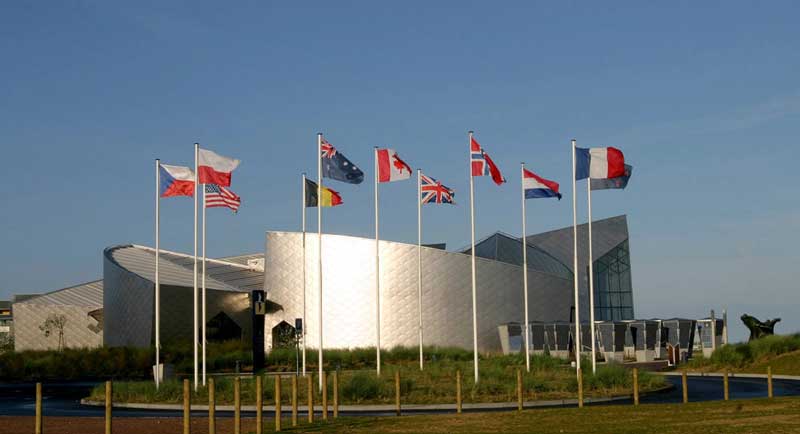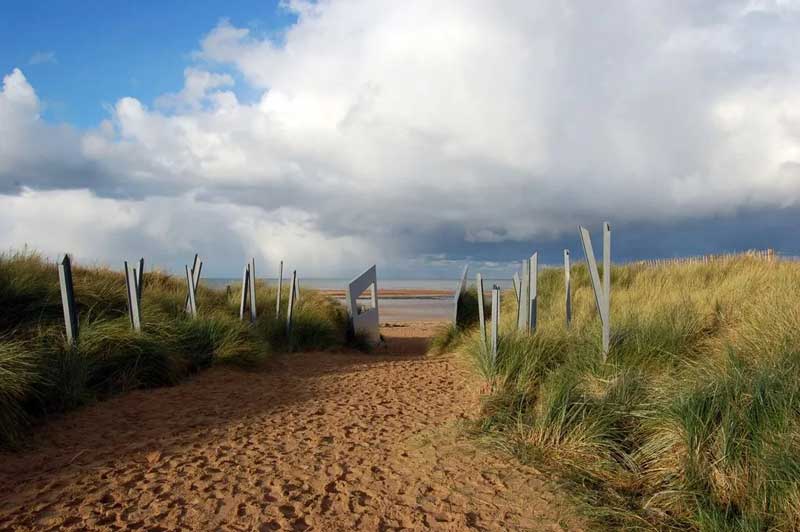The decision came after the Canadian and French governments formulated a plan to help the local council in Courseulles-Sur-Mer purchase the land. Ottawa will contribute about $4 million.
“This is a big day. A big day for Canada. A big day for veterans,” said Veterans Affairs Minister Lawrence MacAulay on Oct. 7. “Tens of thousands of people wrote to me—that does not happen every day—on this issue. In fact, that helps a politician make things move, and we were able to do it.
“I’m just thankful that we got the resolution that we did. That will help Canada and help France … display to the world what we paid for peace and security in the world.”
The museum had been immersed in a costly, two-year legal fight to head off construction of Domaine des Dunes, multiple unit condos in two buildings on lands adjacent to the centre.
The court battle focused on the damage the builder’s use of the centre’s only access road would cause the museum and non-profit charitable corporation. The Juno Beach Centre is dedicated to Canada’s role in the events of June 6, 1944, and the subsequent liberation of the continent.
Some 14,000 Canadian troops landed and 359 died on the 10 kilometres of sand code-named Juno, one of five Normandy beaches where the bulk of 156,000 Allied soldiers launched the invasion of Nazi-occupied Europe.
It was the outset of what the commander of Allied forces in Europe, U.S. General Dwight D. Eisenhower, called “The Great Crusade.” More than 5,000 Canadians would be killed during two-and-a-half-months of fighting in Normandy alone.
The strongpoint at Courseulles-sur-Mer, on the estuary of the Seulles River, was the Germans’ most robust defensive position in the Canadian area of operations.
With H-hour delayed until a higher tide cleared offshore reefs and obstacles, the Canadians landed there later than their Allies to the west, giving the German defenders advance warning of the assault.
“Juno Beach is one of the most sacred places in Canadian military history.”

The 19-year-old Juno Beach Centre has attracted more than 1.5 million visitors. The condo development threatened its survival.[JBC]
Campaign organizer Cindy Clegg described the condos as “a step too far for Canadians.”
“Juno Beach is one of the most sacred places in Canadian military history,” Clegg said in a release. “The battle on June 6, 1944, was an extraordinary example of Canadian acts of personal courage. Today, the Juno Beach Centre, Canada’s Second World War museum on the site of the landings, honours their memory, preserving the story of Canadian servicemen and women who put their lives on hold—or sacrificed them entirely—to fight for a better world.”
She said the plan by development firm Foncim “threatened the sanctity of the site and the Centre that preserves the story of those who fought at such great cost to secure Juno Beach.”
Federal officials worked with the French government and local administrators for months to find a solution after the pro-development council that negotiated the original development deal was ousted in recent elections.
Under the new agreement, two other parcels of land adjacent to the one at issue will form one site as a part of a 99-year lease to protect it from development.
The Juno Beach Centre has received more than 1.5 million visitors since it opened in 2003, 28 per cent of them Canadian and 36 per cent French citizens. A record 103,000 visited in 2019, D-Day’s 75th anniversary year.
The centre’s roadway is the only way in and out of the site. The museum paid for its construction on land administrators of Courseulles-sur-Mer leased to it for 99 years “for the sole purpose of providing visitors with access” to the facility.
Foncim lawyers launched legal action for the right to use the route. Museum resources were almost exhausted fighting the effort when a judge in nearby Caen upheld the building permit and ordered the road open to the developer last spring.
“This agreement will safeguard and preserve this portion of Juno Beach for future generations.”
The half-million-dollar legal battle had centred around the argument that 22 months of construction traffic would pose “an existential threat” to the museum and “the Canadian memorial presence in Normandy.”
Les Amis du Centre Juno Beach and residents of Courseulles-sur-Mer were vocal in their opposition to the project. The mayor who approved the permit, Frédéric Pouille, was voted from office. His successor, Anne-Marie Philippeaux, opposed the project but apparently could not revoke the permit.
The specific site where the condo would have been built is a former battlefield where the remains of soldiers killed on D-Day—likely German, say historians—are believed to still lie.
Philippeaux said her government acted to make good on a promise her predecessors undertook more than two decades ago.
“By purchasing this land in the Juno sector, with the intent to make it available to Canadians, the elected officials of Courseulles-sur-Mer are continuing the commitment of the elected officials who, on Nov. 10, 2001, made land available to the Juno Beach Centre … in honour of all those who served in the Canadian military during the Second World War,” she said in a statement.
MacAulay said Ottawa had been involved in the process since April. He thanked the French and local governments for their efforts to help resolve the issue.
“The story of Juno Beach and the Battle of Normandy, and the brave folks who fought there, represent a vitally important chapter in our history. This agreement will safeguard and preserve this portion of Juno Beach for future generations.”
“I cannot express how grateful we are to learn that our country will help preserve these sacred grounds,” said the president of the Royal Canadian Legion, Bruce Julian. “Our soldiers fought and died there during the Second World War, and this is a place to quietly remember their sacrifices.
“We thank the Government of Canada and the municipality of Courseulles-sur-Mer for recognizing the sanctity of this territory and taking concrete action to preserve it. May we always Remember our Fallen soldiers.”
Advertisement





















